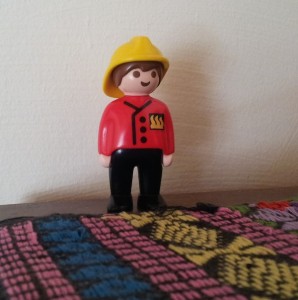When my second child was a baby, I read somewhere that although imaginary friends are common for firstborns, they are much less common for subsequent children. The writer’s opinion on this phenomenon was that a) the older siblings teased the younger ones out of having imaginary friends, and b) the younger ones didn’t really need them, anyway.
That was all I needed to cement my resolve that if my second wanted to have imaginary friends, our family would welcome them with open arms!
Our first child’s first imaginary friend turned up one day when he was two. I noticed that he was holding something carefully pinched between his thumb and forefinger. The thing was very small… or invisible.
“What do you have there, Buddy?” I asked.
“This is Peter,” he said solemnly.

We have no idea where he got the name Peter, as the crowd of friends that followed had rather more fanciful names: Seiterint, Peachwiss, Snakeless… His friends hung around for years. They were the source companionship at an age when he had trouble connecting with other kids, and a great source of family lore. We especially loved Seiterint, who lived on an island near Japan and who sometimes did naughty things in our household.
So we watched carefully for the arrival of our second child’s set of imaginary friends. As soon as we saw it, we had a heart-to-heart talk with her older brother, letting him know that older siblings were often the cause of kids being embarrassed about their imaginary friends, and this wasn’t going to happen. Given that at age 5 his imaginary life was still going strong, he became a willing participant.
Our younger child’s friends were complete different and just as wonderful in their own way. They grew out of her affection for a burpcloth that she carried around with her, so of course, the first one was named “Burp” — or, in her dialect, “Bup.” Burp soon acquired a host of companions all named Burp with added initials or last names. Burp lived in La Selva House, which is in Africa. Eventually, she decided that Africa was the next-door neighbor’s front yard.
I am glad that we were so successful in nurturing our second child’s imaginary friendships. Just like our son, her imaginary friends carried her through the years that she was developmentally out of step and didn’t connect with other kids. At the tail end of our son’s imaginary friendships (at least, that he told us about!), they even created a connection through their worlds. Our son had given his imaginary friends an imaginary airline, which he drew logos for and told stories about. Our daughter joined in, creating her own imaginary airline and offering us tickets and even issuing pilot licenses.
Both of my children now have healthy friendships with other [real] children. Although preschool teachers were always fretting about whether they would ever graduate past parallel play with kids their age, they eventually got it. But just as in other developmental areas, they were simply on a different developmental path. It’s hard when you’re a parent to withstand pressure from outside to mold your young children to social expectations. I will never forget the terrible feeling of my grandfather taking my blanky from me and saying I was too old for it — and will also never forget how my mother got it back to me later that day.
Imagination is one of the most wonderful things about childhood – before children are self-conscious enough to hide it, they can create the friendships they need, play out social scenarios, and incorporate fascinating details from the wider world into their own little lives.
 Hoagies’ Blog Hop August 2014: Gifted Friendships
Hoagies’ Blog Hop August 2014: Gifted Friendships
Friendship. One word that has many meanings. For most kids, friends are those they play with. But for the gifted child, friendship is often far more than that. Gifted friendships can be more complex, more deep, and more difficult to find. Read more at Hoagies‘.
Comments
5 responses to “Imaginary friends”
Sweet!
Such creative minds! It’s like reading about Terry Prachett’s Discworld.
I love imaginary friends. I had Nakadie and Hackie-Dacky as a child and my twins have too many to count. At almost eight, they are still a part of our lives. I had a parent come up to me last year saying, “I had no idea you had a teenage daughter!” I looked at her confused for a moment, and then said, “Oh, you must mean Lisa.” Lisa is my daughter’s older [imaginary] sister. In kindergarden she got “in trouble” for including all of her [imaginary] siblings in the family portrait she drew. Her [real] twin sister was scolded for including her wolf brothers and rat father (“Justin” from Rats of Nihm) (who was holding hands with her [real] father, my husband, in the portrait). We now homeschool.
Wow, your house must be crowded! That is truly a teacher lacking an appreciation for imagination.
haha, yes it does feel crowed sometimes. I think I need a flowchart to explain what’s going on to visitors.